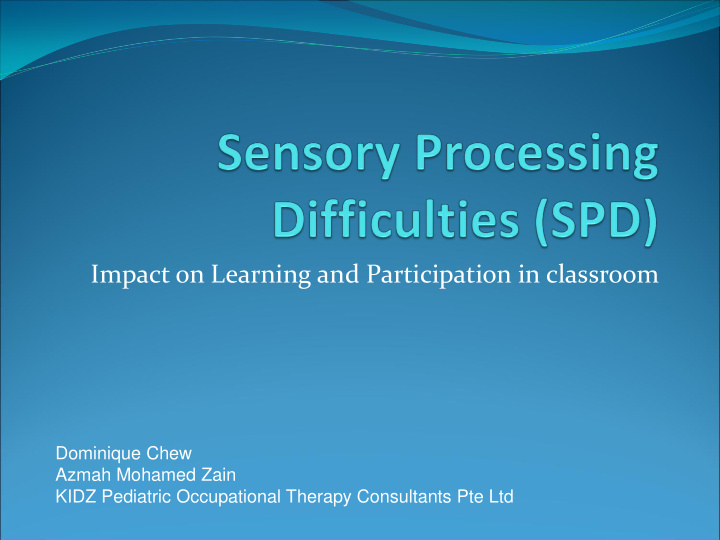



Impact on Learning and Participation in classroom Dominique Chew Azmah Mohamed Zain KIDZ Pediatric Occupational Therapy Consultants Pte Ltd
AGENDA What is SPD? How does it link to learning & motor skills Understanding and analysing behaviours in the classroom Strategies to facilitate learning and participation in classroom
WHAT IS AN OCCUPATIONAL THERAPIST? “a health professional concerned with improving a person’s occupational performance.”
WHAT DOES AN OCCUPATIONAL THERAPIST DO? Child’s Occupational Performance Areas: Work / Productivity Self Care Leisure
ENCOURAGE INDEPENDENCE
WHAT IS IT? WHY DO WE NEED IT? HOW DOES IT IMPACT LEARNING AND MOTOR SKILLS?
Sensory Processing Disorder A condition that exists when sensory signals don not get organised into appropriate responses (from SPDorg.com)
We are Sensory Beings …. • We use our bodies to get the sensorimotor experiences to help self-regulate • Our arousal level is affected by sensory input • We use our senses to make sense of and to learn about the world
OUR SENSES • Touch (Tactile) • Taste (Gustatory) • Smell (Olfactory) • Hearing (Auditory) • Sight (Visual)
OUR SENSES Vestibular (movement sense) Proprioceptive (muscles and joints)
External Senses Internal Senses Olfactory Vision Vestibular Taste Auditory Interoception Proprioception (Internal Tactile Organs) 12
Under responsive Over responsive
We take in information (sensations) We make sense of the information (perception) We respond and act (performance) 14
Touch (Tactile) SKIN is the largest organ of the body It tells us when we are being touched Oral-tactile (Senses inside mouth) 17
Tactile (Touch) Protection Discrimination “ Flight, fright, fight ” Where is the touch? What kind of touch? What is touching the body? e.g.: light, hot, pain Quality of the touch? Which is alarming, comforting, to be ignored or to be explored? 18
Gross motor control Fine motor control Oral Motor Control Praxis Emotional TACTILE Arousal Level security SENSE Visual Body perception awareness Social skills Effects on Everyday Skills 19
PROPRIOCEPTION SYSTEM • Unconscious awareness of the position of our body parts. • Makes sense of touch and movement experiences • Assists in Body Scheme Development, for Motor Planning. • Closely linked to vestibular system (modulation and self regulation)
Grading of movement & pressure Body awareness PROPRIOCEPTIVE Postural stability SENSE Arousal Level Emotional security Praxis Effects on Everyday Skills 21
VESTIBULAR SYSTEM Related to movement, gravity & balance Strong relationship with the auditory and visual systems
Bilateral coordination Muscle tone Movement & balance VESTIBULAR Emotional SENSE security Praxis Arousal Auditory language Visual spatial level processing processing Effects on Everyday Skills 23
When all senses are integrated we can: regulate (modulate) ourselves before learning new skills i.e.: feel safe develop our motor skills (gross & fine motor) plan our physical actions (motor planning) interact with the environment and people appropriately and meaningfully 24
How do we help our students to attain and change their arousal level in class or at home? Regulate attention Promote learning Improve behaviour
LINK to Learning
Not all behaviours are sensory!
Challenging Behaviors Appeared noncompliant, difficult, strong-willed or hyperactive Described as intense, persistent, sensitive, slow to adapt or energetic
Challenging Behaviors A behavior is considered ‘ challenging ’ when it affects functioning of our daily activities (ADL) – self-care, work/productivity, play ability to attend, learn and master new skills social interaction and communication
Types Of Behaviors Seeking Behaviors Avoiding Behaviors To obtain / gain/ achieve To avoid perceived something i.e.: attention, threatening situations/ objects, sensory inputs, activities i.e.: difficult etc tasks, change schedules OR To escape from aversive/ unpleasant sensory input i.e.: ‘ loud ’ noise, movements, etc
Fidgety on seat Pushing friends Biting objects Tantrums Off seat often Spaced out Sleepy Compensatory/ Coping Sensory based Communicative Reasons for Behaviours
Seeking Behaviours Compensatory/Copi Communicative Sensory ng Need/Want an object/activity Attention Productive Non Underresponsive Personal needs - Smiles, Hugs Productive food, drink, Stimulate sensory Being in control Self toileting processing injurious to Shock/Surprise Preferred objects/ Postural tone & release reactions activities arousal Endorphins
Avoiding/Escaping Behaviours Compensatory/ Communicative Sensory Coping Attention/ Event Task/Activity Over responsive Pain/Discomfort Desired activity is Over interrupted or changed stimulated Hunger Avoid Task too difficult Sensory Illness strangers, processing situations Fear of failing a task disorder
Be a Detective - OBSERVE Is the behaviour challenging? What are they doing? Do they avoid an activity most children enjoy? Are they overly excited/”hyper”? When do you see the behavior? After recess? At the last hour? How long does it last?
SEEKING Biting (non – food obj) Coping Sensory (seeks P/T) ( stress) Dislikes arousal lvl task/ task too difficult Auditory visual- To ???? filtration spatial attention
SEEKING Fidgety (on seat) Coping Sensory Compensatory (due to (seeks V ) stress) To Dislikes arousal postural task/ task lvl too difficult tone visual To Poor core Poor auditory ???? strength endurance tracking attention memory
Hits SEEKING classmates/obj ects Sensory Communicative (Seeks T/P) Poor gradation Seeking of force attention exerted Want to be in Poor body control/Rigid/ awareness Perfectionist Why?
AVOIDING Hits classmates Coping ( stress) Dislikes activity/ Dislike being touched or Task too being in a crowd difficult Over responsive Why? to T
There is no magic recipe for ALL!
General Strategies Activities that help achieve optimal arousal level for learning and attention to happen, can either be ALERTING or CALMING Your selection of activities depends on: students’ arousal level 1. environment (i.e. classroom setting) 2. logistics 3.
GOLDEN RULE Always choose “ heavy muscle ” work (proprioceptive based) when dealing with big group of children Any activities that involve muscle action against resistance i.e. pushing, pulling, carrying, lifting
Golden Rule “Heavy Muscle” work, on its own, is usually “safe” – not too alerting or calming “Heavy muscle” work can be combined with: Movement (vestibular) Touch (tactile)
Group Activity MOVEMENT BREAKS Frequent, short, intermittent Do “heavy muscle” work alone or combined Let’s try some activities!
Recommend
More recommend